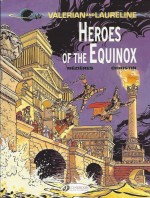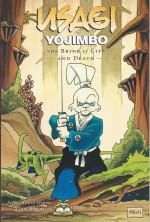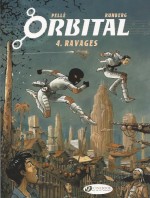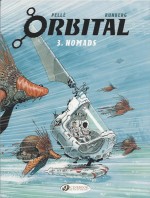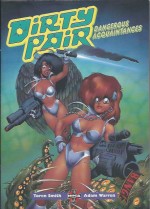
By Roman Dirge (Titan Comics)
ISBN: 978-1-78276-131-0
Lenore is a sweet little girl who has cute, if somewhat surreal, little adventures. Did I mention that she is also dead and has been for quite some time? Well she is, and her friends are just as outré…
Wittily weird, aggressively eccentric and darkly hilarious comic strips featuring this edgy little charmer and her fluctuating coterie of arcane acquaintances have been entertaining audiences since 1992 when she first appeared in San Diego’s alternative arts magazine Xenophobe.
Slave Labor Graphics picked up “the Cute Little Dead Girl†and featured her eerie escapades in a proper comicbook from February 1998 to July 2007, which led to a series of 26 Flash-animation shorts on Sony’s ScreenBlast website in 2002. There’s toys, game merchandising stuff and a movie in the works…
In 2009 Titan Comics took up the publishing option on Lenore’s uniquely unreal print excursions and have subsequently repackaged and remastered her entire career in a series of hardcover chronicles.
This sixth collection (re-presenting issues #8-11 of the second volume) offers more mercurial madness and even an origin of sorts which all begins after an elucidatory Introduction from current editor David Leach, describing the author’s creative process. ‘Some Things Are Best Left Unseen’ highlights a big change in status for Lenore and her most enduring associates. Former vampire and current not-so-cuddly toy Ragamuffin, bucket-headed demon/on-sabbatical bounty hunter Pooty Applewater and indescribably enigmatic arms-length protector Taxidermy have been with the beguiling tot for ages now…
Lenore died a hundred years ago in the little town of Nevermore but Taxidermy’s story begins much earlier: either in 1880 when a very foolish French archaeologist opened the wrongest tomb in Egypt or else millennia before that when the almighty gods locked one of their own exalted pantheon within it.
Taxen-Ra was a small god dedicated to avenging small wrongs done to children. Over centuries he became busier redressing balances and grew mightier with each punishment, but eventually he was forgotten until a plague wiped out so many young ones that he snapped…
Determined to wreak bloody vengeance on everyone who had allowed children to suffer he attacked his fellow deities and had to be put away forever…
Once fame-hungry modern historians freed him, however, he resumed his task: an impossibly efficient serial killer dubbed “Orphanage†who slaughtered the parents and guardians of abused kids all over the world…
Now TV ghost-hunting show Ghosty Toasty has tracked Orphanage to Nevermore, and a dilapidated old house which none of the crew can see is occupied by a little dead girl and her friends.
Well, cameraman Big Joe can, but nobody will listen to him so he’s staying safely locked in the van whilst his butt-hole bosses all endure their well-deserved fates…
Always happy to indulge in a few high-spirited pranks and japes, the kids are blithely unaware that thanks to modern technology their antics as well as Taxidermy’s highly imaginative dispatch of the intruders has been streaming live to the entire planet…
More long-sought-for revelations are forthcoming in the three-chapter ‘Downfall’, beginning with ‘Part #1′ as the true circumstances of Lenore’s tragic demise are revisited.
The little miss quickly returned to her happy home after she passed and she has never accepted her beloved mama’s horrified rejection of her. All this time the frequently forgetful waif has been waiting for Mother’s inevitable return, unaware that Orphanage long ago ensured that it could never happen…
In the present – but over in France – a mysterious woman sends an army of well-equipped agents to capture Lenore and her chums but sadly the best that science and money can provide is less than effective against the unquiet – and rather mischievous – dead. The worst that happens is the pals experiencing the trippiest hallucination imaginable, before Lenore finds herself at the Rainbow Bridge explaining herself to every pet she’s ever accidentally killed (and in a century that’s a lot)…
The super-soldiers are just unleashing their next level of technological ingenuity when Taxidermy shows up, but before he can get going there’s a big bang and a couple of very annoyed Egyptian gods materialise…
‘Downfall Part #2: Downfall…ier’ escalates the craziness as Nevermore turns into a thaumaturgical ground zero impossible to describe, with outrageous gags trumping appalling supernatural carnage whilst Ragamuffin and Pooty argue over who’s going to tell Lenore the shocking secret they’ve just uncovered about her revenant rebirth…
Acting as grotesquely bad-taste scatological palate cleansers, short tales ‘Lenore in Old Mother Hubbard’ and ‘Lenore in Goldilocks and the 3 Bears’ gives those of us who still need oxygen a breathing space before everything comes to a spectacular conclusion in ‘Downfall Part #3: DownfalliestAlottaBunches’ with the warring gods ending their millennial duel in the only way they can before little Lenore reaches her own unique accommodation with all those unhappy inconvenient truths…
To Be Continued…
There’s still plenty of fun to be had however and ‘Bonus Section’ holds more variant and unused covers – 11 in total throughout this tome of terror – plus ‘inside cover-art’ from #8-11 and the death-affirming scene ‘Mr. Gosh Sucks’.
Also included is ‘Guest Art’ by Maxwell Vex, a crafty ‘Lenore Puppet Tutorial by Bonnie Burton’ (never run with scissors and be careful not to prick your fingers – you never knows who’s watching or hungry) and a selection of ‘Cover Concepts for #11’ closes out our Easter Eggs Incubated in Hell section…
Impossible to fairly describe but so absolutely necessary to read, these stories are richly dipped in the traditions of Charles Addams: scary, poignant, grossly frat-boy funny and appealing to the same skewed and twisted audiences who adore Jhonen Vasquez’s Squee! and Johnny the Homicidal Maniac or goth-inspired series such as Gloom Cookie or Giffen & Roman’s i Luv Halloween – not to mention the animated films of Tim Burton.
These weird and wonderful fables are an unwholesome treat for those kids of all ages with a taste for the richer, darker and less wholesome flavours of life – and its inevitable end, if not cessation. Ever so much better for you than giving poisoned candy to kids who bang on your door.
Lenore is ™ & © 2015 Roman Dirge. All rights reserved.




